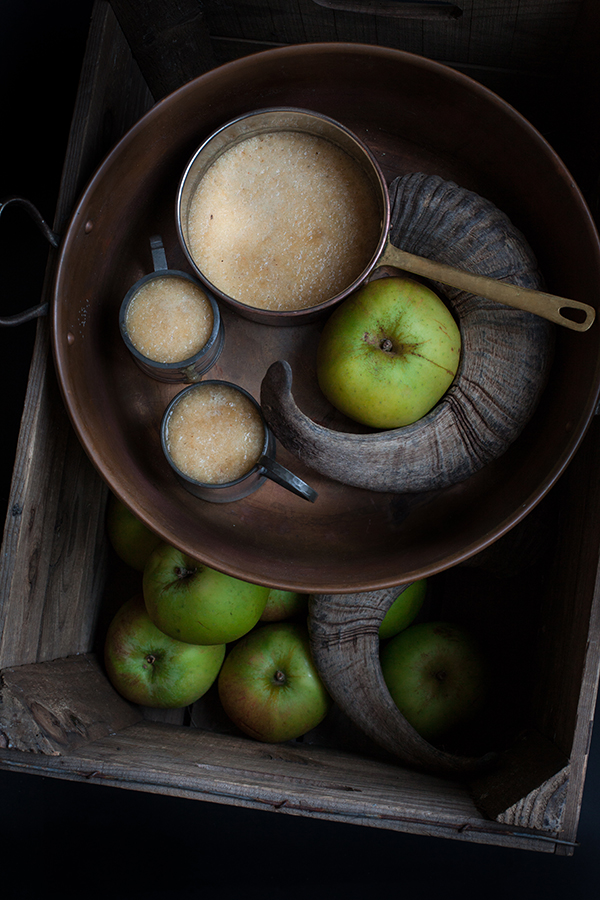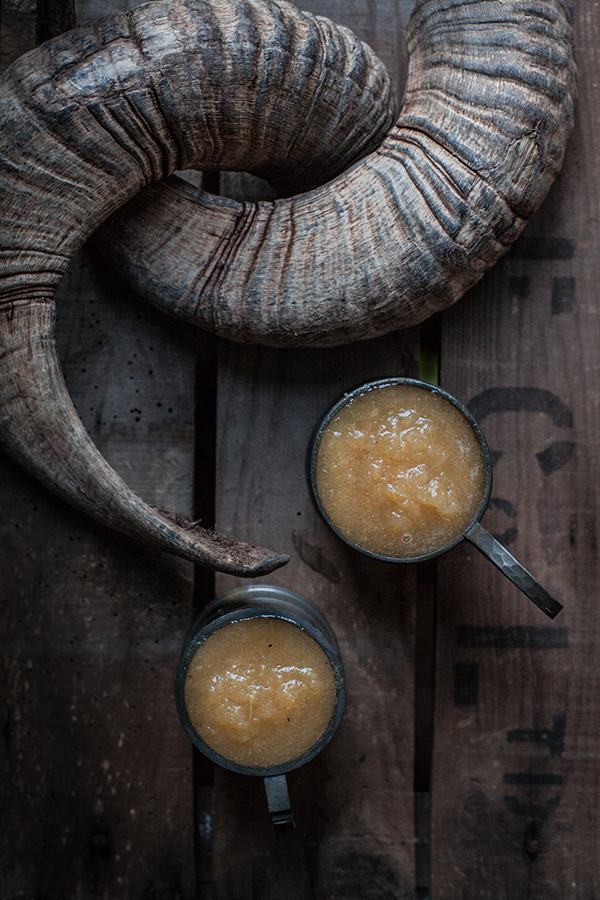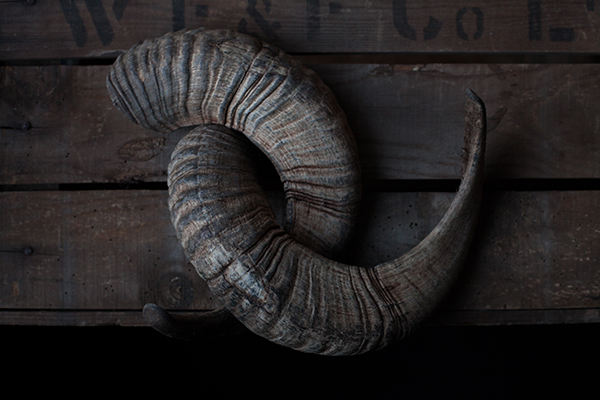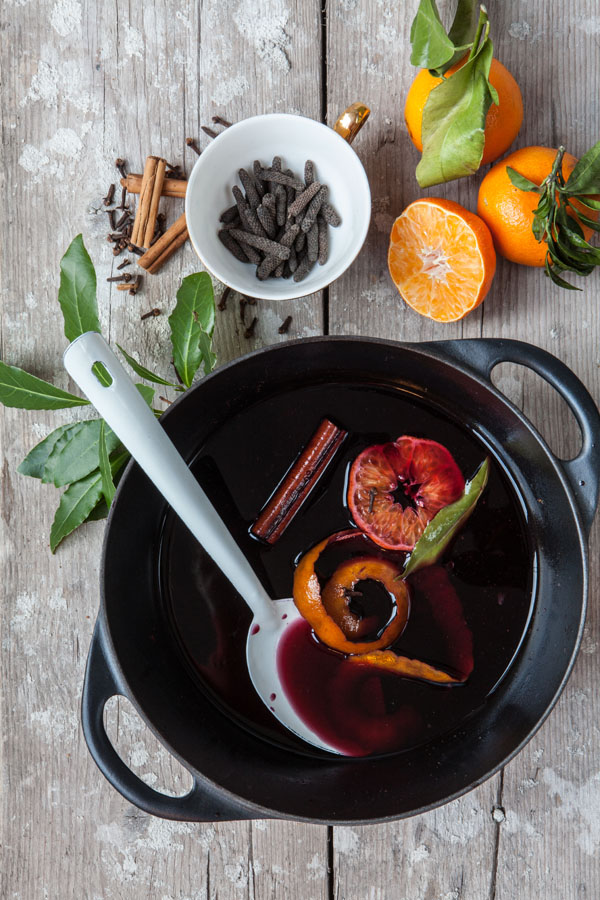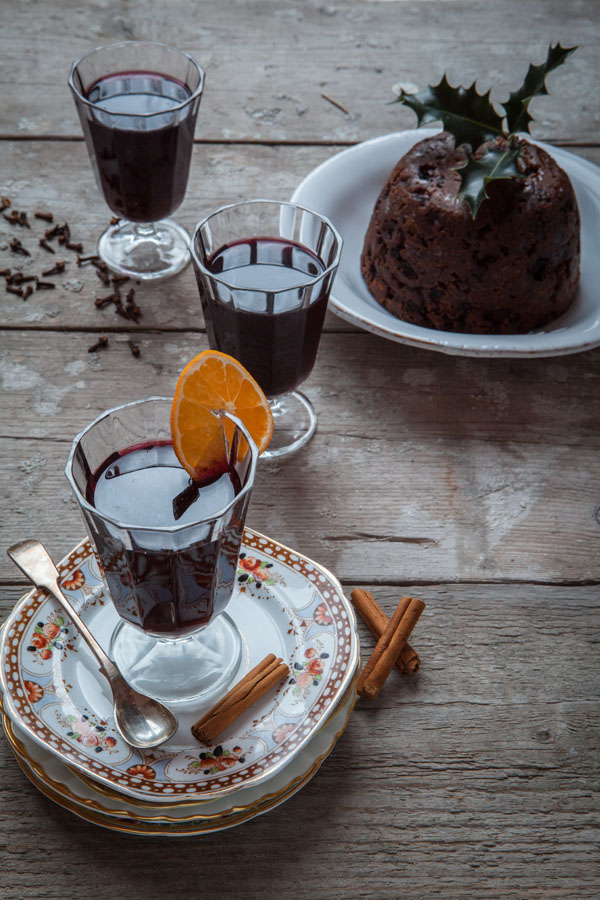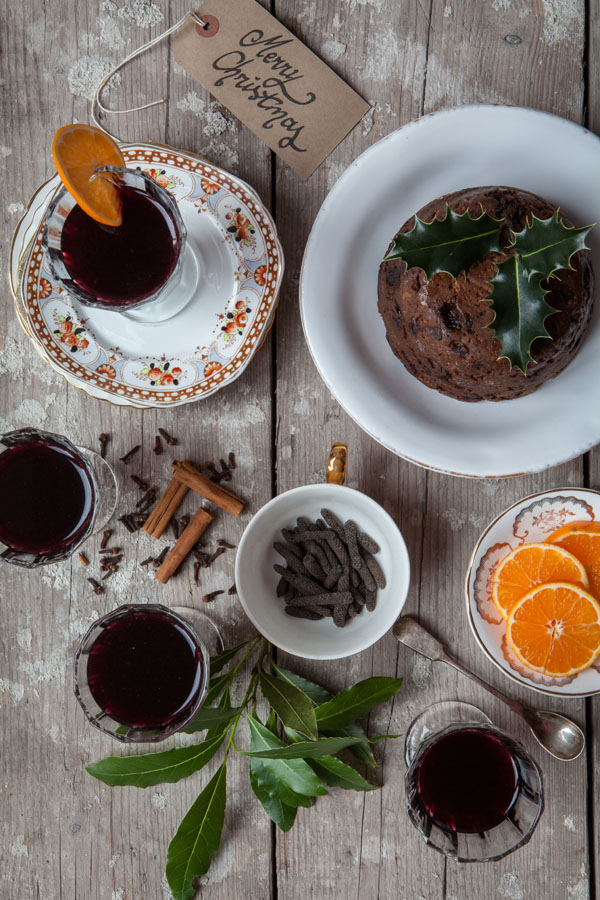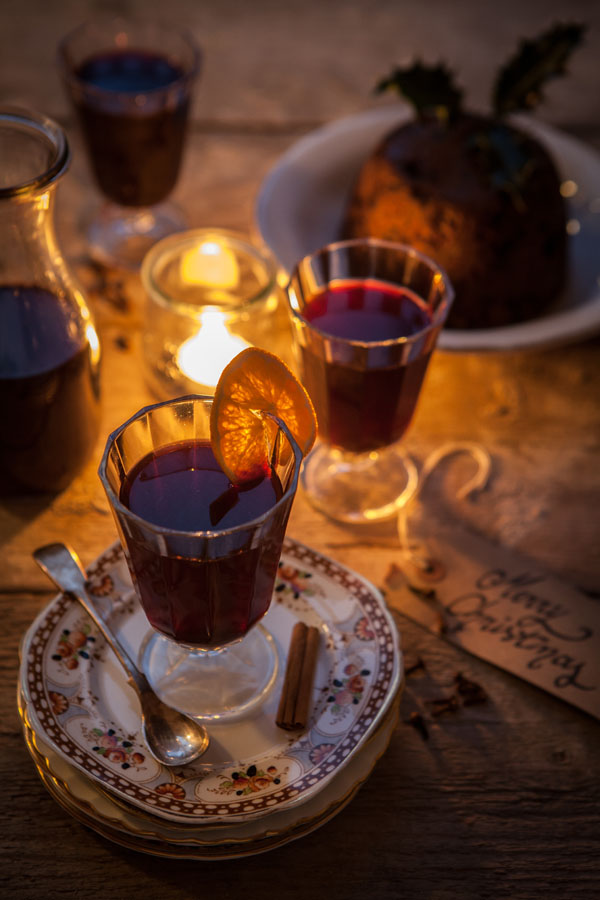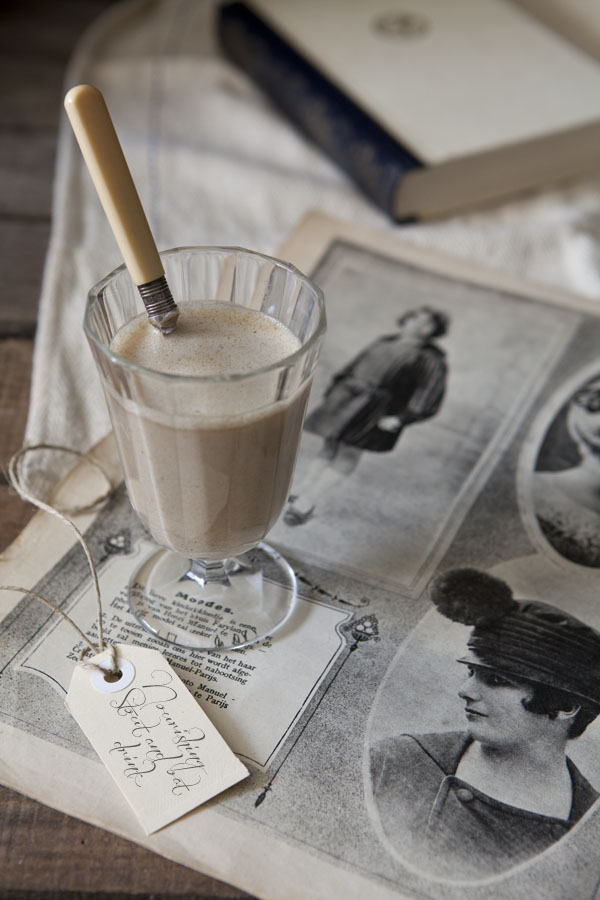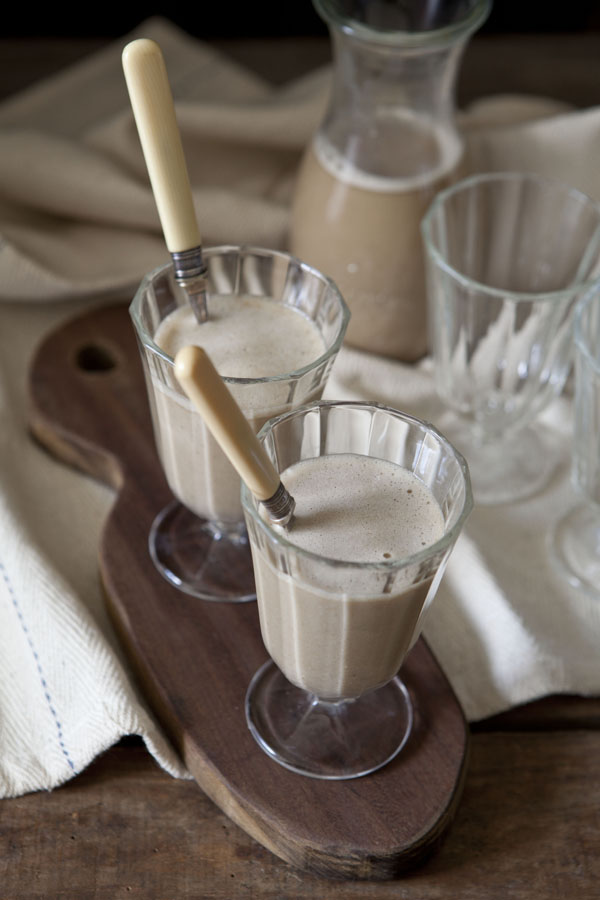The post We shall drink Lambswool on the Twelfth Night appeared first on Miss Foodwise.
]]>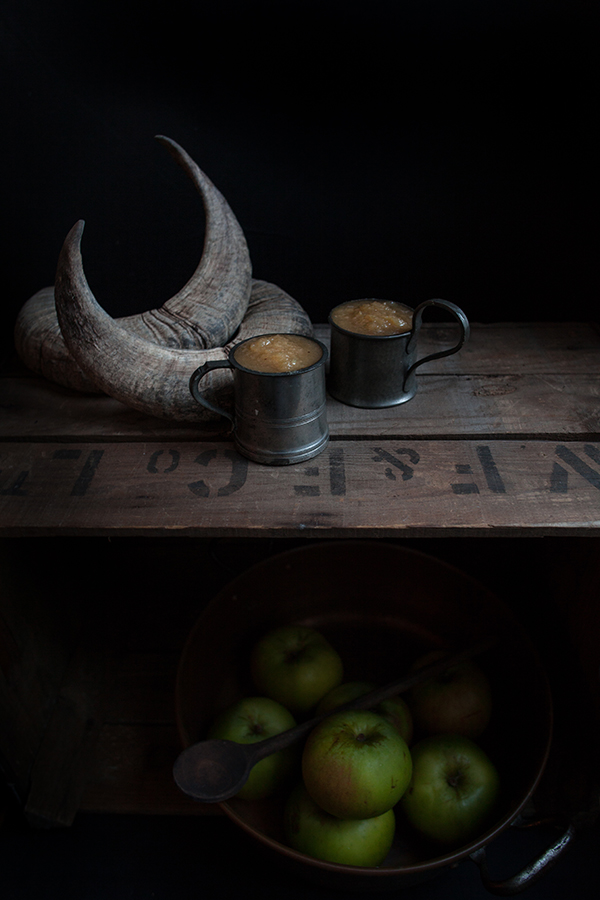
Although I was brought up with a lot of Pagan traditions, living in the city of Antwerp meant that some customs were harder to follow than others. As city dwellers far removed from any orchard or field, we were ignorant to the traditional rites surrounding harvest and sowing time. If there is no nature to honour, no field to gather around the cleansing fire, the feasting quickly becomes part of the past and forgotten.
Industrialisation has brought us wealth and the choice of matching shoes with handbags on a regular tuesday morning. It has brought the technical bits and bobs we all love and loathe. The big world has become smaller and the challenges bigger. The lucky few still live outside of the ever growing concrete cities. We follow their lives on Instagram with a sense of nostalgia, as if we have ever experienced living surrounded by trees and liberating fields and forests, and then tragically lost it.
But that is what it is, we have lost something, and most of us can feel it. There have never been more depressed people, nor have there ever been more people who are unhealthy because of their eating habits, eating too much rather than starving, but malnourished nonetheless. Our daily bread is soiled with adulteration, slowly making us ill. Animals are kept away from fields and live their ever shortening lives on the concrete floors of factory farms to keep the cost of your daily need low, fruit is left on the trees to rot because farmers can’t afford to harvest it, the price a farmer gets for his milk hasn’t gone up in 20 years (based on Belgian farms) so milk is being sprayed onto the soil of the farmland where the cows can no longer roam freely because of bureaucratic nonsense about fertilizer. Small scale generation long fishermen turn their boats into flower beds because the fishing quotas set out to protect fish stocks have made it so that only the big destructive factory fishing vessels can make a living, scooping up the fish only for part of it to be actually consumed and the rest turned into animal feed because their nets just catch too much for it all to be sold and cooked by us humans. The fisherman that could have made his day by catching one Dover Sole, now has to trow it back, while the big monsters take and take and kill the sustainable fishing industry.
We got lost as humans, because we lost part of our human nature.
Let today be an Epiphany.
The Epiphany is the Christian feast that concludes the twelve days of Christmas. In Pre-Christian pagan traditions this marks the time for Wassail. The practice of ‘wassailing’ meant singing and drinking in the apple orchards on the Twelfth Night to awaken the trees, to warn of the evil spirits and pray for a good harvest in the autumn. It could be that the feast of Wassail comes from the Celtic festival called ‘La Mas Ubhail’, the Feast of the Apple. Wassail comes from ‘waes hael’ meaning ‘be thou healthy’ or ‘be whole’, a salutation in Old English. During the feast these words would be addressed to each other and to the oldest apple tree in the orchard.
A drink traditional to Wassail is called ‘Lambswool’ and it is very possible that ‘La Mas Ubhail’ got phonetically Anglicised, to ‘Lamasool’ and later ‘Lambswool’. In historical books we often see that a lot of words were written down phonetically, resulting in a number of different ways to note down one single word.
Robert Herrick, a mid 17th century poet mentioned the custom of Wassailing and Lambswool in his poem about about Twelfth Night, we also get an idea of the recipe too:
Next crown the bowl full With gentle lamb’s wool Add sugar, nutmeg and ginger, With store of ale too; And thus ye must do To make a wassail a swinger
Give then to the king And queen wassailing : And though with ale ye be whet here, Yet part from hence As free from offence As when ye innocent met here.
The drink Lambswool is a mulled ale, poured over hot apple puree, although some people swear by whole apples, or apple pieces cooked in spiced cider or ale. However, as far as a drink goes, you can’t swallow a whole apple, nor can you swallow apple pieces so it is most probable that the recipe containing whole apples is just derived from the recipe made with apple puree. It is possible that the soft puree resembled a lambs fleece to people in the old days, resulting in giving it the name of what they associated it with, lambs wool.
Another reason for thinking that an apple puree was used it that this is the end of the season, so the apples which are left in times before refrigeration and fancy techniques to keep fruit from ripening, would not have been the prettiest of the bunch. An hot and spiced apple puree fortified with ale would be warming on a january evening, and would allow people to prepare it in a kettle rather than an oven which is used for the recipe with whole apples. Remember this is a country dish and ovens were a privilege for the well-to-do. But the sugar in the dish also tells us this wasn’t a drink for the poor, it could have been a special treat from the lord of the manor, or from the farmer to his farm labourers.
Last year I spoke to you about the intriguing Twelfth Cake, a fruit cake elaborately decorated with sugar or wax figurines which was also a privilege for the well-to-do. This cake, which is also mentioned by Herrick in his poem also started of as a humble ‘plum cake’ for the feast of Wassail. City folk picked up on it and adjusted the cake to their festive needs, making it the centrepiece of the table and causing queues in front of bakeries. Because it became popular in the city and with the wealthy, we get our first recipe for it in a 1803 book. A recipe for Lambswool is more difficult to find, as the drink remained in the countryside. So judging from the poem of Robert Herrick, I came up with this recipe for you.
Lambswool
serves 6-8
What do you need
- Bramley or Cox stewing apples, 500 gr (peeled and cored about 300 gr)
- water, 100 ml
- sugar 100 gr
- freshly grated nutmeg, 1 teaspoon
- ginger powder, 1 teaspoon
- a good ale, 750 ml
Method
Peel and cut your apples in small pieces and place in a pot along with 100 ml of water and the sugar and spices. Stew until soft and puree so there are no bits left.
When ready to serve, heat up the apple puree and add the ale while whisking. You should get a nice froth while doing so. Serve at ones.
Are you celebrating the Twelfth Night? Or are you having a slice of King cake, galette Du Roi or Driekoningen taart? Or are you wassailing and drinking Lambswool?
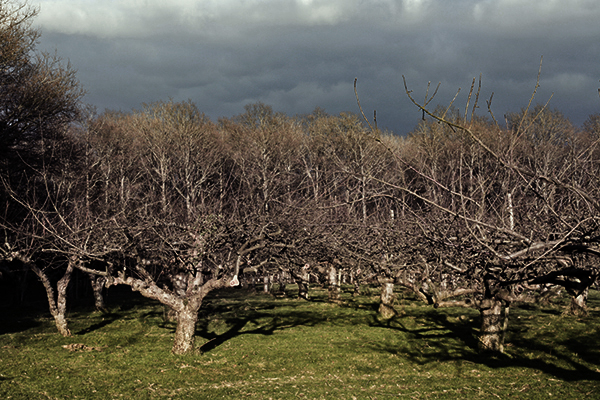 |
| Ancient apple trees in Sussex |
You might also like
Twelfth Cake for Twelfth Night >
The post We shall drink Lambswool on the Twelfth Night appeared first on Miss Foodwise.
]]>The post To make Ypocras appeared first on Miss Foodwise.
]]>And then it is suddenly christmas again… it seems only yesterday that it was september and now we are only moments away from januari. It will be march in the blink of an eye and when it’s august you will be wondering where those months have gone to.
When you are a child, the days seem to drag on like weeks and the weeks like months but when you are all grown up… you wonder where that hour of free time went to and when you are finally able to start reading that book you’ve got to read in the summer.
To warm your spirits after the last busy weeks of the year 2013, a year that has brought me excitement, friendship and a new venture of which I will tell you all about very soon – I had mulled wine on my mind.
The sweet scent of the warm wine and spices always transport me back to the christmas markets in Aachen. My parents and I would drive to Germany especially for it each year. Even from a young age I would be allowed half a cup of mulled wine to warm my hands and to bring a rosy blush to my ice cold cheeks. It was one of the highlights of my year, to take in the different scents in the air, the aniseed of the artisan candy being made, the greasy smell of Reibekuchen, the aroma of spices blended with chocolate from the Aachener Printen biscuits and the mulled wine and rum.
Sometimes the very unlikely of foods and drink can be the ones that have been around for centuries and some recipes never changed very much.
Mulled wine or ypocras as its name was for centuries, has been around since the Middle Ages but mulled spirits pre-date Medieval times. I found a recipe for a fine spiced wine in a Roman cookery book that looks a lot like the recipe for ypocras. It is commonly thought that the drink is named after the Greek physician Hippocrates, however this is not so. It is more likely that ypocras has this name because the herbs and spices were strained through a conical filter bag known as a Manicum Hippocraticum – sleeve of Hippocrates. The Old French name for Hippocrates was ypocrate which explains the etymology of the Middle English name ypocras, hipocras, ipocras, ippocras, hvpocras, hvppocra, and many more variations.
The spice mixture for ypocras was known as ‘Gyle’ and usually contained cinnamon, grains of paradise, long pepper and cardamom pods. These spices were bruised with a pestle and mortar and then left to steep in the red or white wine overnight or possibly even longer to soak up all the flavours.
One can assume that ypocras was used for medicinal purposes rather than for feasting as in recipes it is often mentioned as the perfect tipple after dinner to aid digestion. The oldest recipes therefore include many more herbs which will have given the spiced drink more of a cough syrup flavour than the enjoyable winter warmer we know today.
The first English recipe for Ipocras dates from approximately 1390 and goes as follows:
Pur fait Ypocras,
Treys Unces de canell. Et iij unces de gyngener. spykenard de Spayn le pays dun deneres. garyngale. clowes, gylofre. poivr long, noiez mugadez. maziozame cardemonij de chescun i.qrt douce grayne de paradys flour de queynel de chescun dimid unce de toutes. soit fait powdour and serve it forth.
The recipe is more a list of ingredients and assumes the cook knows the proportions and that a red or white wine is to be used. Sugar was a precious ingredient and only for the lord and master so Ypocras would only contain sugar in the wealthy homes while the common folk sweetened their drink with honey.
Ypocras was common enough to be mentioned in literature as Chaucer wrote In his Merchant’s tale in the 14th century “He drynketh Ypocras, Clarree and Vernage Of spices hoote t’encreessen his corage.” and John Russell’s The Boke of Nurture even contains a ypocras recipe in verse.
Through history we find a vast amount of recipes for this spiced drink, but not only for the spiced wine. Before hops were being used in beer, there was a mixture of herbs known as the ‘Gruut’ that was used to flavour and preserve the beer. Mankind has always been searching for flavourings to tinkle the taste buts.
After the 16th century recipes become more richer including more sugar, oranges, lemons, almonds and apples. My recipe uses cinnamon, cloves, long pepper, nutmeg and clementine juice with a few tablespoons of home made sloe gin. I used raw cane sugar which worked rather well instead of white loaf sugar.
Sometimes I will add marjoram and cardamom like in the first recipe but because of the marjoram it started to taste rather savoury. It is still very pleasant and not a flavour you’d expect in a mulled wine so it is a definite option to add it if you want something different. The long pepper added enough spice so I didn’t need to use the dreaded ginger but if you are a ginger lover, feel free to add it as you please. I would have loved to add Grains of paradise but I had no way of getting my hands on them.
Regula Ypocras
What do you need
- 2 bottles of red wine, not your cheapest, not your most expensive.
- 4 buds of long pepper, crushed – email me if you can’t find it, I know where you can get it.
- 5 cloves1 fresh bay leaf
- 1 teaspoon of grated nutmeg, freshly grated please
- 1 stick of cinnamon
- 100 g raw cane sugar
- the peel and juice of 1 clementine
- 3 tablespoons of sloe gin, or cherry brandy, you can omit this
Optional
- 1 sprig of marjoram
- 1 pod of cardamom, bruised
Method
heat up 200 ml of red wine with the sugar and the spices, juice and peel until it dissolves, boil for 10 minutes and then simmer for 5 more. Add the marjoram if you are using it and leave to cool, when nearly cold or cold, add the rest of the wine and the sloe gin and leave to take up those lovely flavours overnight. You can even freeze the wine and spice mixture before adding the rest of the wine.
Strain, bottle and keep in the fridge until needed then gently heat up before use – don’t allow it to boil or you will loose the alcohol and we won’t want that.
You might also enjoy
Raspberry vinegar >
Sloe Gin >
Damson cheese >
Cobnut Brandy >
The post To make Ypocras appeared first on Miss Foodwise.
]]>The post Nourishing Stout and Oat Drink appeared first on Miss Foodwise.
]]>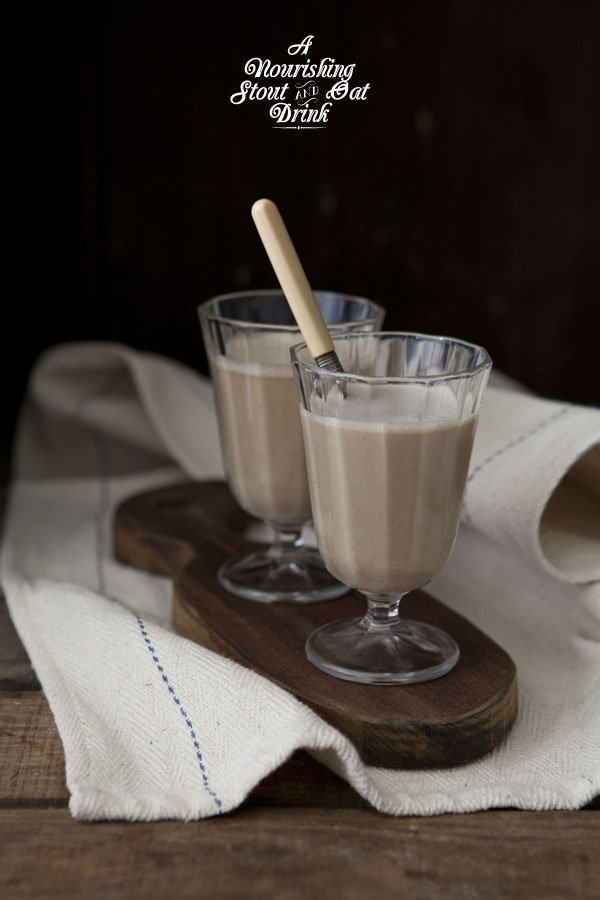
My mother always told me she and my grandmother loved drinking a Trappist beer when they were breastfeeding, she said that it was nurturing for new moms and that in the old days the nurses would actually bring a beer to the mothers to stimulate the lactation process.
But it isn’t just a myth, if a nursing mother drinks a good old pint of beer, the yeast and hops in it will help increase her milk supply. Hops are also calming, so good for the new mom. Brewers yeast is also taken as a supplement to boost the milk supply by mothers who do not enjoy the taste of a lovely beer.
Trappist is a Belgian beer but I think Stout is the prefect beer for this recipe as I’ve heard stories about mothers receiving a Stout when they have given birth, a Nourishing Stout would have been better but sadly those haven’t been brewed commercially for decades. Milk Stout is called that way because it used to contain lactose, a sugar derived from milk. Lactose doesn’t only add sweetness to the beer, it also adds calories which is why together with the yeast and hops in the beer it was given to lactating mothers. Although Milk and Nourishing Stouts only became popular after the First World War, the usage of lactose and the mentioning or illustrating of it on the beer labels was forbidden after the Second World War due to rationing.
The only surviving Milk Stout is Mackeson’s, I came across it by accident when I was at Tesco’s a few months ago, the can still shows a milk churn that has been Mackeson’s trademark since it was first brewed in 1907 at the Mackeson’s brewery in Hythe, Kent. Mackeson’s is now brewed by InBev so I doubt that there is still any lactose in the beer today.
As I am creating this concoction for my friend and fellow blogger Zita who gave birth to a healthy little boy a few hours ago, I am going to make it as nutritious as I
can.
Now luckily I know Zita does like an occasional beer so I’m not
bringing her anything she wouldn’t like to drink. I am including a way to remove the alcohol from the beer in the recipe, so it is ‘safe’ to drink for those who are worried about getting their newborn drunk. This drink isn’t
solely for nursing mothers, it is also for the dad, the friend, the guy
in the street and the health food lover. It is packed with nutrition.
To go with the Stout I’m making my own Oat milk.
Oats have a low glycemic index, which can help to regulate blood sugar
levels and make you feel fuller for longer. They also contain lots of vitamins,
minerals and antioxidants, are a good source of protein and complex carbohydrates.
You can use 3 types of oats for this recipe, the groats which are the oat kernels with the hulls removed, rolled
oats which are steamed groats that have been rolled out and flattened and steel
cut oats which are the oat groats chopped up. Steel cut oats are therefore the
best choice as they contain more of their original nutrients but they are not as easy to find as rolled oats.
To break down the phytic acid content which makes the oats more digestible and reduce anti-nutrients so your body can soak up a lot more of the nutrients, I soaked the oats with cider vinegar. You can also use live yoghurt as lactic acid fermentation.
This drink is for all those who love Stout, if you don’t care for Stout I don’t recommend you try this drink as it is quite bitter. The bitter Stout works perfectly with the sweet oats, and even has notes of a coffee with lots of milk.
Before you skip to my recipe, have a look at our feast for Zita!
Maybe you remember the Virtual baby shower we did last summer, today were are back with a whole new table of food, follow the links to the blogs to read the other ladies recipes:
Our Menu
Giulia: Scarpaccia
Regula: Nourishing Stout & Oat Drink
Beth: Moghrabieh Salad with Preserved Lemon and Coriander Pesto
Jasmine: Whole Wheat Flour Cocoa Cookies
Artemis: Kasopita – Cheese Pie from Εpirus
Sarka: Kiwi Carpaccio with Pecans and Manuka Honey
Emiko: Ricotta and Dark Chocolate Cake
Sneige: Pomegranate Curd with Seedy Pine Nut Crust
Simone: Pistache Raspberry Cakes
Karin: Fresh Pea Souffle with Goat Cheese
Nourishing Stout and oat drink
What do you need
Start the evening before, or in the morning.
To prepare the oats:
- Steel cut or Rolled oats, 1 cup (you can use the groats if you can find them)
- apple cider vinegar (or live yoghurt), 1 teaspoon
- water, 2 cups
For the drink:
- water, 2 cups
- 1 date, stoned (2 if you like it sweeter) and cut finely
- Stout or Guinness, 1 cup
- a fine sieve
- a blender or food processor
Method
- Combine the oats, cider vinegar (or yoghurt) and water in a bowl, cover loosely and leave to soak for at least 8 hours.
8 hours later …
- Drain your oats by straining them through a fine sieve, discard the soaking water
- Rinse the oats gently to remove the starch
- Put the oats and the date into the food processor (I used my Vitamix) and blend
To make this drink with alcohol free stout:
- add one cup of stout to a small saucepan and bring to the boil, simmer for 5 minutes then let it cool. (the drink will taste less bitter with this method)
- Add two cups of water and one cup of stout and blend again until creamy
- At this point you can strain your oat milk through a fine sieve again to remove any of the oats, I choose not to, to keep the drink smooth and a little thicker. Discarding the oats is trowing away nutritious food.
- If you want to strain, you can keep the leftover oats to make cake or pancakes.
Leave the drink to rest for 30 minutes – 1 hour before use
Enjoy!
You might also like
Strawberry and Pimm’s Granita
Drunken cherries
Cobnut Brandy
Sloe Gin
The post Nourishing Stout and Oat Drink appeared first on Miss Foodwise.
]]>